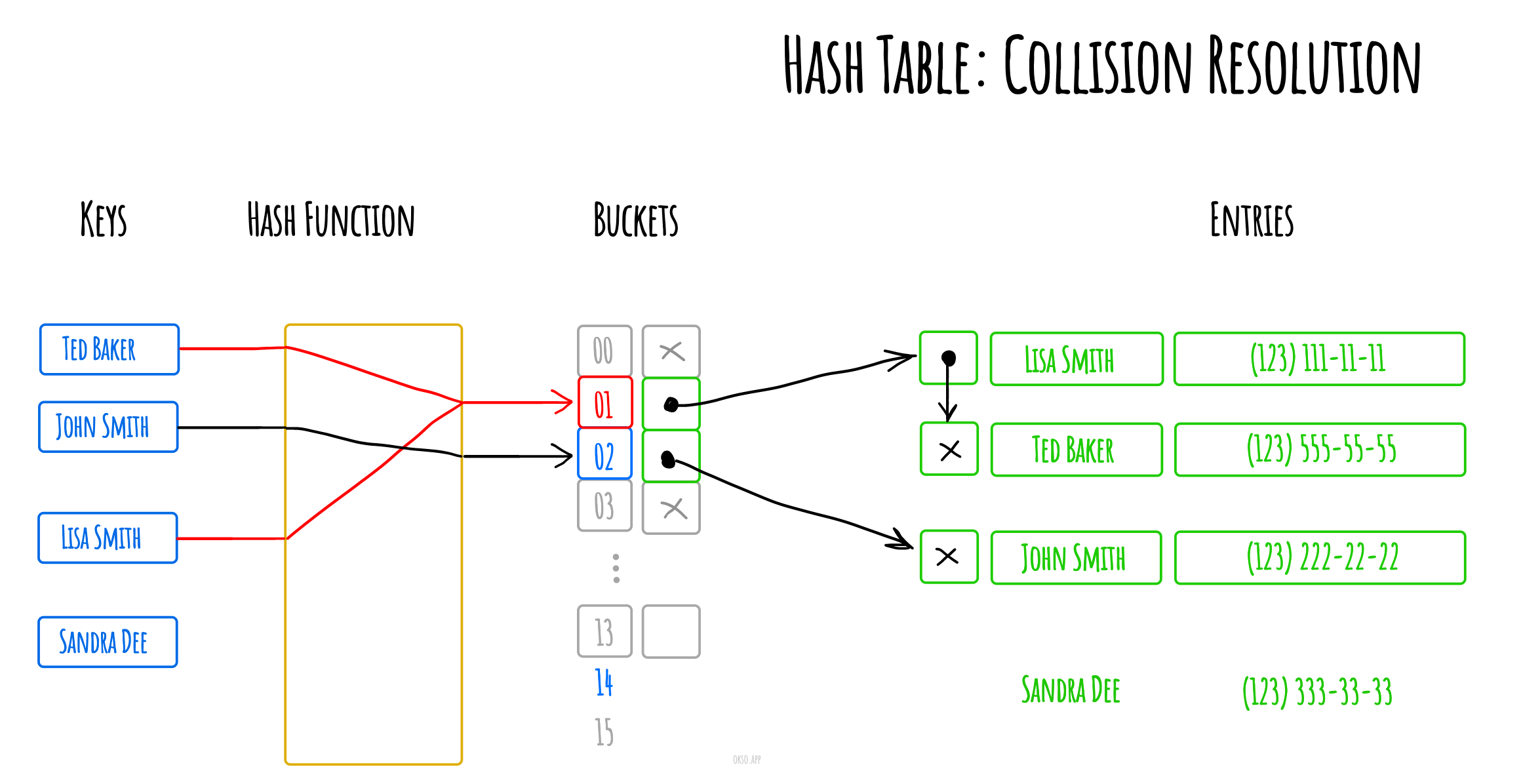哈希表 在计算中, 一个 哈希表(hash table 或 hash map) 是一种实现 关联数组(associative array)
哈希表使用 哈希函数/散列函数 来计算一个值在数组或桶(buckets)中或槽(slots)中对应的索引,可使用该索引找到所需的值。
理想情况下,散列函数将为每个键分配给一个唯一的桶(bucket),但是大多数哈希表设计采用不完美的散列函数,这可能会导致”哈希冲突(hash collisions)”,也就是散列函数为多个键(key)生成了相同的索引,这种碰撞必须
通过单独的链接解决哈希冲突
构造函数 constructor 1 2 3 4 5 6 7 8 9 10 constructor (hashTableSize = defaultHashTableSize ) { this .buckets = Array (hashTableSize).fill (null ).map (() => new LinkedList ()); this .keys = {}; }
hash(key) 方法 1 2 3 4 5 6 7 8 9 10 11 12 13 14 15 16 17 18 19 20 21 22 23 hash (key ) { const hash = Array .from (key).reduce ( (hashAccumulator, keySymbol ) => (hashAccumulator + keySymbol.charCodeAt (0 )), 0 , ); return hash % this .buckets .length ; }
用于将给定的键字符串转换为哈希数.
set(key, value) 方法 1 2 3 4 5 6 7 8 9 10 11 12 13 14 15 16 17 18 19 20 21 22 set (key, value ) { const keyHash = this .hash (key); this .keys [key] = keyHash; const bucketLinkedList = this .buckets [keyHash]; const node = bucketLinkedList.find ({ callback : (nodeValue ) => nodeValue.key === key }); if (!node) { bucketLinkedList.append ({ key, value }); } else { node.value .value = value; } }
这个方法的作用是向哈希表中添加或更新键值对。它接受一个键和一个值作为参数,并根据键的哈希值找到对应的桶。然后,它检查桶中是否已经存在相同的键。如果存在相同的键,则更新已存在节点的值为新的值。如果不存在相同的键,则在桶的末尾添加一个新的节点,该节点包含新的键和值。这样,通过调用 set 方法,可以将键值对添加到哈希表中,或者更新已存在键的值。
delete(key) 方法 1 2 3 4 5 6 7 8 9 10 11 12 13 14 15 16 17 18 19 20 21 22 23 delete (key ) { const keyHash = this .hash (key); delete this .keys [key]; const bucketLinkedList = this .buckets [keyHash]; const node = bucketLinkedList.find ({ callback : (nodeValue ) => nodeValue.key === key }); if (node) { return bucketLinkedList.delete (node.value ); } return null ; }
作用是从哈希表中删除指定的键值对。它接收一个键值作为参数,并根据键值的哈希值在哈希表中找到相应的链表。然后,它在链表中查找具有相同键值的节点,并将其从链表中删除。最后,它返回被删除的节点,如果没有找到匹配的节点,则返回 null。
get(key) 方法 1 2 3 4 5 6 7 8 9 10 11 12 13 get (key ) { const bucketLinkedList = this .buckets [this .hash (key)]; const node = bucketLinkedList.find ({ callback : (nodeValue ) => nodeValue.key === key }); return node ? node.value .value : undefined ; }
这个方法的作用是从哈希表中获取与给定键相关联的值。它通过计算键的哈希值,找到对应的桶(链表),然后在桶中查找具有相同键的节点。如果找到了节点,则返回节点的值;否则返回 undefined。简而言之,这个方法实现了哈希表的查询功能。
has(key) 方法 1 2 3 4 5 6 7 8 has (key ) { return Object .hasOwnProperty .call (this .keys , key); }
这个方法的作用是检查给定的 key 是否存在于当前对象的 keys 属性中。它返回一个布尔值,如果 key 存在,则返回 true,否则返回 false。这个方法可以帮助我们判断一个特定的键是否存在于对象中。
getKeys() 方法 1 2 3 4 5 6 7 getKeys ( return Object .keys (this .keys ); }
这个方法的作用是获取 this.keys 对象的所有键,并以字符串数组的形式返回这些键。它可以帮助你在需要获取对象键的时候,快速地获取到这些键的列表。
getValues() 方法 1 2 3 4 5 6 7 8 9 10 11 12 13 14 getValues ( return this .buckets .reduce ((values, bucket ) => { const bucketValues = bucket.toArray () .map ((linkedListNode ) => linkedListNode.value .value ); return values.concat (bucketValues); }, []); }
这个方法的作用是获取哈希表中存储的所有值的列表。它通过遍历哈希表中的每个桶,并将每个桶中的链表节点转换为对应的值,然后将所有的值添加到一个数组中,并返回该数组。这样,我们就可以轻松地获取哈希表中所有存储的值。

